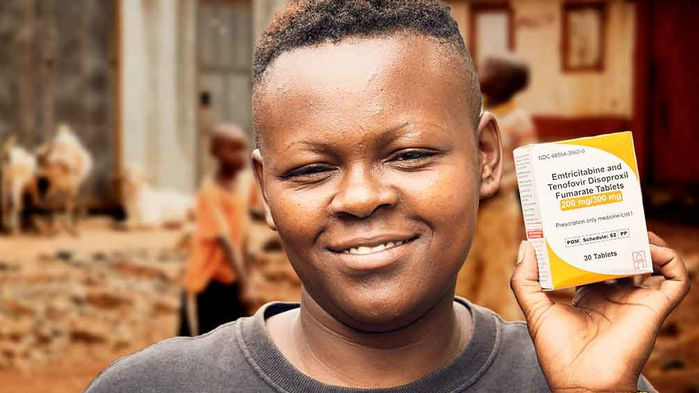BOSTON—There’s no question that a simple regimen of a single daily pill can slash HIV infections in people at risk. But although millions of people around the world could benefit, only 200,000 are prescribed what’s called pre-exposure prophylaxis, or PrEP, and 75% of them are in the United States. The disparity was the focus of anguished discussions this week at the largest annual U.S. HIV/AIDS conference. “I’m frustrated,” says Linda-Gail Bekker, a researcher at the University of Cape Town in South Africa. “We have nearly 1700 infections every week in young women and girls, and this might be a way to throttle this.”
PrEP, which uses antiretroviral (ARV) pills made for treatment as preventives, faces multiple obstacles, as Bekker and other discussed at the Conference on Retroviruses and Opportunistic Infections here. Many countries already struggle to provide ARVs to people who are infected and say they can’t afford PrEP for the large uninfected populations who need it most. People at substantial risk of becoming infected by HIV may not know about PrEP or may reject it, as several presentations highlighted. And PrEP raises touchy issues including teen sexuality and the appearance of advocating risky behavior.
Yet PrEP works. Its effectiveness in several clinical trials led the U.S. Food and Drug Administration to approve preventive use of ARVs in 2012. The World Health Organization in 2015 recommended PrEP for everyone at “substantial risk” of becoming infected—a total of tens of millions of people, to judge from the nearly 2 million new HIV infections in 2016. In some countries, including the United States, the targeted groups are “key populations” such as men who have sex with men (MSM) and sex workers. In sub-Saharan Africa, where most people become infected from heterosexual sex and many have no “high-risk” behavior, large swaths of the population are candidates for PrEP.
Two presentations at the meeting underscored its power. In San Francisco, California, the number of people using PrEP more than tripled from 2013 to 2016, to 12,300. Researchers found that the city’s new HIV diagnoses dropped by 43% during that period, although they note that it isn’t easy to disentangle the impact of PrEP from other factors. In Australia, the state of New South Wales launched a PrEP project that began enrolling MSM in 2016. As Andrew Grulich, an epidemiologist at the University of New South Wales in Sydney, reported, more than 9000 MSM have now started PrEP. In the first half of 2017, Grulich says the team saw a “very substantial decline” in new infections—a drop of 35%.
Only one hard-hit country in sub-Saharan Africa, Kenya, aggressively promotes PrEP—13,000 people are now using it—and Kenya only launched its program last year. South Africa has an HIV-infected population estimated at 7.2 million, more than any country, and yet only 5000 or so uninfected people are using PrEP. At a cost of a few hundred dollars a year per person for drug and monitoring, PrEP would add to the enormous economic burden that the country already faces in trying to treat all infected people, Bekker acknowledges. But she says the government is also wed to a flawed analysis that suggested PrEP wouldn’t be cost effective outside the highest risk groups such as sex workers and MSM.
Global PrEP users

Even the United States was slow to adopt PrEP, and several studies at the meeting explored why people who might benefit do not ask for it. Many do not recognize that they are at high risk of infection. Others worry about side effects—long-term use of the drugs can cause bone and kidney problems. Some simply prefer condoms or don’t want to take a daily pill. A study in four southern U.S. cities found that of 72 women who were deemed “PrEP eligible,” only four had ever heard of it. Another study of 201 transgender black and Latina women—a population that has one of the highest new infection rates in the country—in Washington, D.C., and Baltimore, Maryland, found that 86% knew about PrEP. But only 39% had tried it, in part because of unfounded concerns about interactions with hormones they were taking.
Many researchers and affected communities also worry that PrEP could backfire if it increases risk-taking behavior such as having sex with more partners or deciding not to use condoms. But studies have not supported these concerns.
François Venter, a researcher at the University of the Witwatersrand in Johannesburg, South Africa, who has tested PrEP in sex workers, says his government is squeamish about offering it to teens, who he thinks could benefit the most. The most effective approach, he says, would be to promote its use in school sex education classes. But he can’t see that happening in South Africa’s “inherently conservative society” any time soon, he says. “Everyone wrings their hands and whinges out about young girls, but we can’t get into schools,” Venter says. “It’s a political and programmatic hot potato.”
Ultimately, PrEP should be treated the same as contraception, Venter says. “You should be able to walk in and buy it over the counter.”
Nelly Mugo, an OB-GYN from the Kenya Medical Research Institute in Nairobi, stresses that it’s important to listen to and address the concerns of PrEP skeptics. “We shouldn’t be discouraged by low initial uptake,” Mugo says. “Maybe we need the slow period for people to be certain the products are good.”
